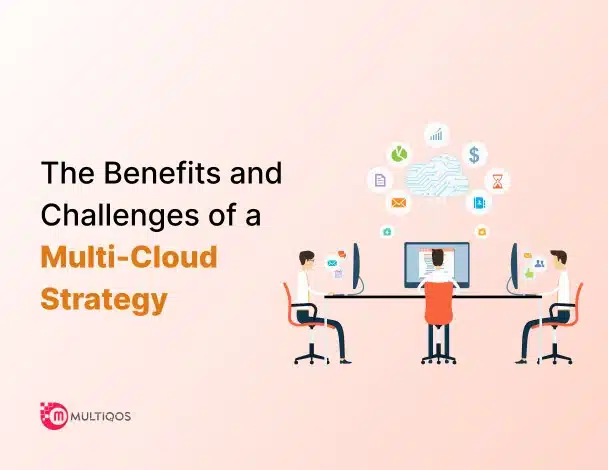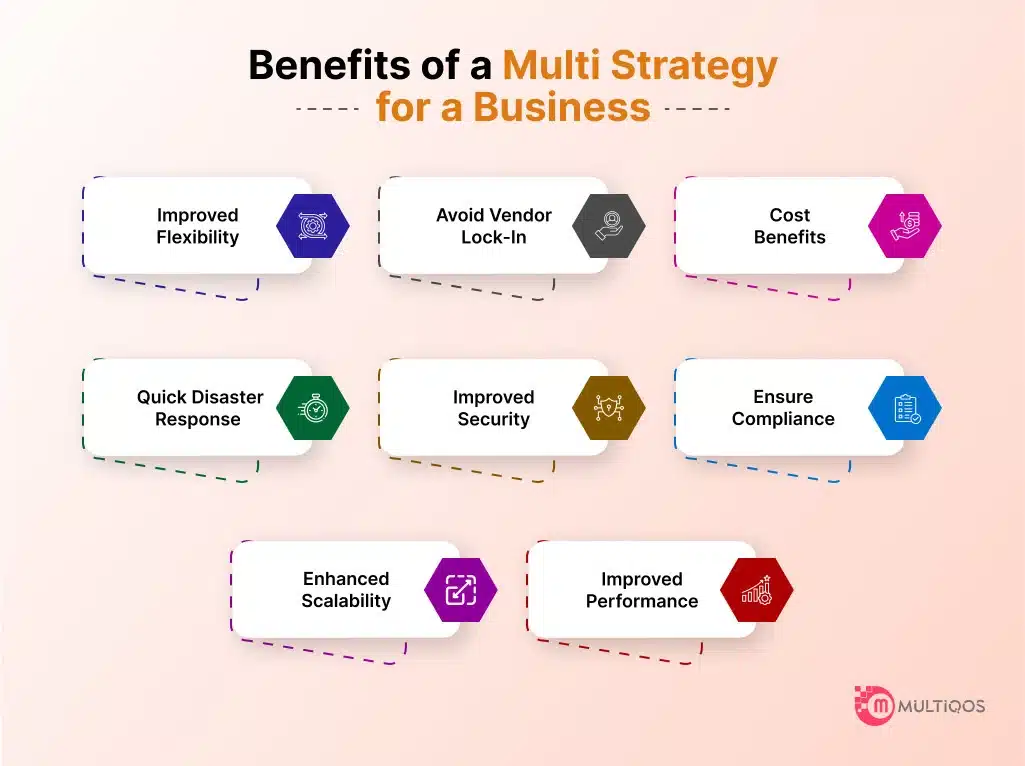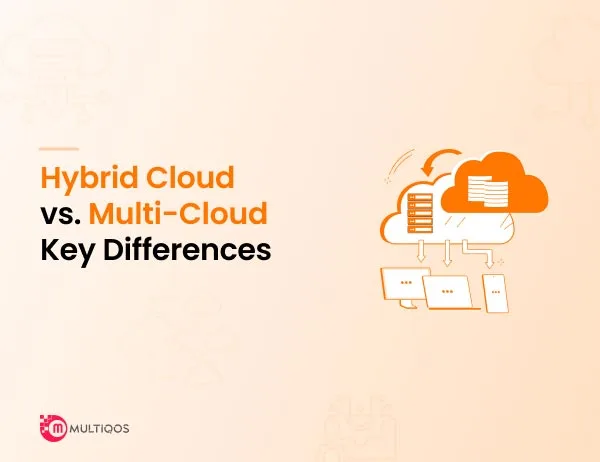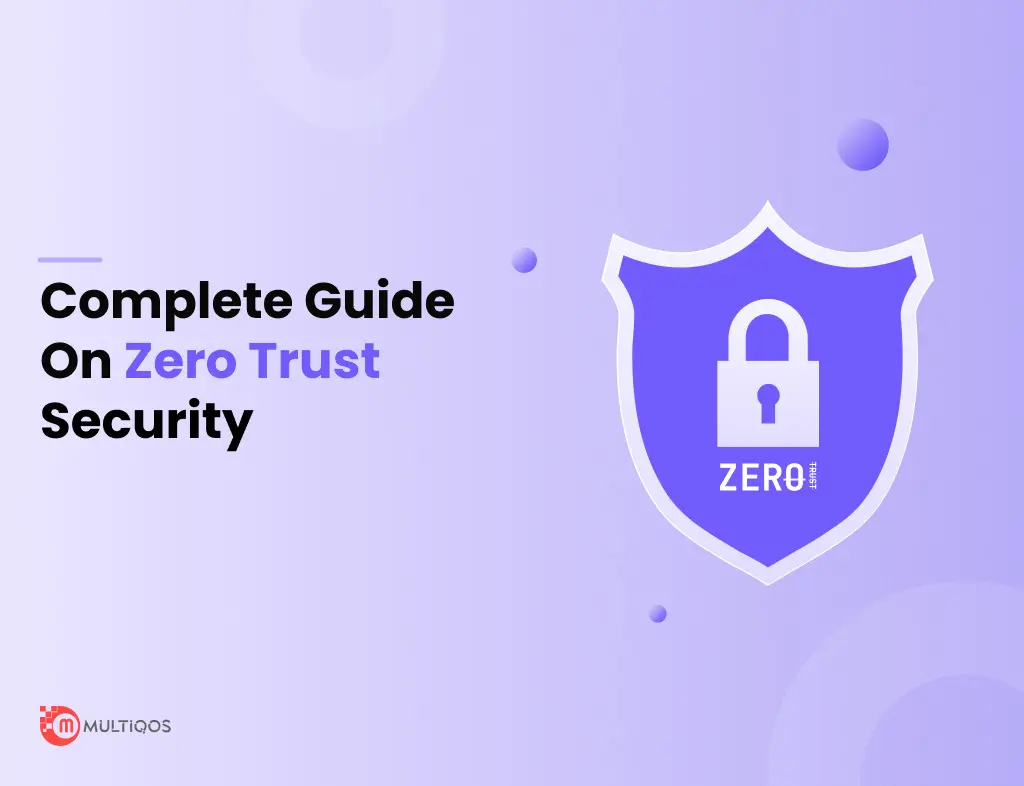The Benefits and Challenges of a Multi-Cloud Strategy

The advent of cloud technology has revolutionized the way businesses operate. It opened new opportunities for businesses, particularly for SMBs. The cloud offers a cost-effective and convenient way to get IT resources to host applications.
However, depending on a single cloud vendor can pose many challenges like vendor lock-in and limited features. This is where a multi-cloud strategy proves beneficial as it allows businesses to take advantage of multiple cloud providers.
By using multiple cloud providers, a business can leverage the best features from different service providers. Hence, it offers enhanced scalability, agility, and more benefits to businesses. If you are considering a multi-cloud strategy for your business then this is useful for you.
This guide will help you understand everything about a multi-cloud strategy including its benefits, challenges, best practices, and more. Dive in for more details.
Understanding the Nitty-Gritty of a Multi-Cloud Strategy
A multi-cloud environment offers lots of opportunities to businesses ranging from plenty of flexibility to significant cost-savings. However, venturing into this domain is daunting and can be confusing without proper planning and guidance.
Here comes the role of the multi-cloud strategy that serves as the guiding force to unlock the benefits of multi-cloud for your business. A multi-cloud strategy involves considering multiple cloud environments for a business. It entails using multiple cloud platforms.
This strategy clearly identifies your goals and outlines the right solutions to meet those goals. It helps you understand which cloud services you need: public, private, or hybrid cloud. Plus, it will help you identify the best cloud partner to fulfill your requirements.
A strategic plan for multi-cloud implementation will help you ensure that the solution aligns with your business needs. It steers your planning in a way that helps achieve the desired outcomes for your business.
To summarize, the multi-cloud strategy is a strategic plan that helps in decision-making when it comes to adopting multi-cloud solutions. It defines a proper roadmap to achieve the objectives of your business.
What are the Benefits of a Multi-Strategy for a Business?
Since a multi-cloud strategy considers the questions related to “how to achieve multi-cloud implementation for your business”, it is crucial to overall business strategy. Understanding the benefits of the multi-strategy is essential. Let’s check out its benefits below.
Improved Flexibility
With a multi-cloud approach, businesses can pick the right services tailored to their specific operational needs. For instance, they can choose AWS for data storage and another cloud service for computational needs. They can pick the right mix of cloud services to get optimal results.
Hence, a multi-cloud approach helps them achieve greater flexibility in cloud development. This strategy offers them the freedom to choose any cloud provider that they think is the best for their operations. This strategy is useful in the dynamic business landscape where needs rapidly change.
Businesses can easily make adjustments to their decisions by adopting diverse cloud solutions with a multi-cloud strategy in response to the changing demands.
Avoid Vendor Lock-In
A multi-cloud strategy helps businesses avoid vendor lock-in because they don’t rely on a single cloud service in this case. When a business uses a single cloud platform, it is stuck with the service quality the vendor offers. Plus, when there is a downtime, the business’s applications are also affected by it.
By adopting a multi-cloud approach, a business can ensure that the application’s infrastructure is spread to multiple cloud services. Consequently, the application will stay functional even if there is downtime in a cloud service.
Choosing a single vendor poses numerous challenges in front of businesses including higher costs and waste of time. Additionally, it becomes difficult for a business to move data and applications to another cloud provider when working with a single cloud vendor.
Cost Benefits
Choosing a multi-cloud strategy can also provide cost benefits as you can choose the service providers based on this aspect. So, you can compare pricing models of different cloud providers and choose a mix of cloud services that yield the maximum cost benefits.
With a multi-cloud strategy, you have options to choose cloud services that are less costly than the others. Plus, you don’t require full-fledged access to a particular cloud service and can choose-as-you-go to optimize the costs.
Quick Disaster Response
You can quickly respond to a disaster with a multi-cloud strategy. For example, if there is an outage in a specific cloud service, your entire operation will not experience an outage. In a multi-cloud strategy, you can spread your data and applications on many cloud platforms to minimize disruptions and ensure the continuity of your business.
With this disaster plan, you can avoid the extra costs that you incur from disruptions and operational hurdles. Moreover, a multi-cloud approach helps you enhance operational efficiency by delivering services without any hurdles.
Improved Security
Another advantage of choosing a multi-cloud strategy is enhanced security. With a multi-cloud landscape, you can implement security measures provided by different cloud providers to enhance your defense mechanism.
Apart from this, when your data and application use multiple cloud services, it is likely to be more secure. When there is a security incident on a particular cloud platform, your data stored on other platforms will be safe.
Ensure Compliance
Data compliance is a big challenge for businesses that can be met by adhering to different regulations. Moreover, these regulations keep on changing regularly from one country to another. Regulations related to data storage, handling, and usage are tricky.
When you opt for a multi-cloud landscape, you can meet compliance-related norms in different time zones. Cloud service providers adhere to regulations and data compliance. By choosing multiple cloud providers, you can ensure that your application adheres to compliance standards.
Enhanced Scalability
Scalability is another key advantage of choosing a multi-cloud model. You can leverage the benefits of various cloud platforms to develop a high-performance and scalable application for your business. Every business has different requirements with no one-size-fits-all solution.
Moreover, a multi-cloud approach enables businesses to spread their workloads on multiple cloud platforms. It increases the scalability of your business by leveraging the services of multiple cloud platforms. It helps businesses get the best multiple worlds.
Improved Performance
Another significant advantage of a multiple-cloud strategy is enhanced performance. Since a business can get the benefits of multiple platforms, they can get a performance boost to their application. Different platforms offer varied performance speeds.
If your current cloud platform doesn’t offer the desired performance, you can opt for a faster cloud service. Plus, you can disperse your application components on different cloud services to achieve optimal performance.
What are the Popular Cloud Implementation Strategies?
There are different types of cloud strategies that companies can adopt to leverage cloud computing solutions for their businesses. Understanding these types can help you pick the right cloud strategy that gives you the highest ROI for your investment. Let’s check out the popular cloud strategies as follows.
Private Cloud
Private cloud can be on-premises or it can be offered by a cloud provider. This type of cloud computing service is meant for a single user or organization. It offers scalability, flexibility, and performance like a typical cloud platform. However, security and privacy are added advantages to the private cloud.
Public Cloud
It is a multi-tenant cloud service that offers services to multiple users or organizations. The public cloud is a popular and common model of cloud services. Amazon AWS, Google Cloud Platform, and Microsoft Azure are some popular examples of cloud services.
They are easily available to the public at a certain subscription fee. Moreover, public cloud is cheaper than private cloud because it is shared by multiple users. But it also involves higher risks of security because of shared usage.
Hybrid Cloud
A hybrid cloud is a combination of public and private clouds. In this type of cloud environment, organizations leverage both kinds of cloud platforms to ensure optimum cost, security, and efficiency. In this case, high-value tech requirements can be handled with the public cloud and confidential information can be stored on the private cloud.
Also Read: Multi-Cloud Vs Hybrid Cloud
Challenges of Multi-Cloud Strategy that Businesses Must Overcome
Multi-cloud is quite a good strategy for leveraging cloud for your business. It offers numerous benefits including enhanced business efficiency. Despite all the good things about multi-cloud, there are some challenges you must know to tackle potential roadblocks.
Cybersecurity
Cybersecurity is a significant challenge in front of businesses that choose cloud solutions. While choosing the cloud offers benefits like reduced costs, operational efficiency, better performance, and enhanced data management, it is not without some critical security challenges.
Data security remains a critical challenge for businesses that want to adopt a cloud strategy. However, the challenge becomes more significant when using a multi-cloud strategy. In this strategy, you are dispersing your application’s data and components to diverse cloud platforms.
Although you take the benefits of the cloud provider’s security features, they aren’t sufficient to protect your data. In this case, you need to think beyond existing security features and implement your own security measures to prevent data breaches.
You can partner with a reliable cloud services company to implement robust security features. Security is a shared responsibility in the case of the cloud and you shouldn’t rely solely on the cloud service provider for this aspect.
Financial
Using a multi-cloud strategy can prove to be costly in the long run as you will be using services of multiple cloud platforms. So, you need to subscribe to many cloud services and pay as per the services you receive. As a result, it could be more costly than using a single cloud platform.
Though you can optimize cost by choosing a combination of cloud services that offer the maximum cost benefits, it is not always possible due to complex pricing structures. Plus, you could be paying extra if the prices are higher in more than one cloud service.
Hence, a business has to consider the financial challenges when it comes to choosing a multi-cloud strategy. Do a complete cost-benefit analysis before making a choice.
Technical
Choosing a multi-cloud strategy can pose a technical hurdle because every cloud provider uses a different set of technologies. Hence, when it comes to deploying your application and data to multiple cloud platforms, you may face technological challenges.
When you choose the features and packages from diverse cloud platforms, you can face compatibility issues. You will need to pay extra costs to get additional resources with the growing business requirements. And, it will increase the costs due to more resource consumption on multiple platforms.
Tips for a Successful Multi-Cloud Strategy
The following are some tips to implement a multi-cloud strategy most effectively.
Define Your Objectives
Begin by identifying your objectives and requirements in the first place. It involves defining your goals for multi-cloud adoption. You can document the requirements and specifications to make the right decisions.
Choose a Suitable Cloud Provider
Choosing the right cloud service providers is essential for a successful multi-cloud strategy. Hence, the process starts by identifying and choosing the right cloud service providers. It is an essential step that you must complete carefully. You can find some cloud service providers and make a list of the best ones. After this, you can pick the right cloud provider that fulfills the requirements.
Evaluate different cloud providers based on the strengths and services they offer. You can decide on some parameters based on your requirements like performance, scalability, security, and more to pick the best cloud service provider. Apart from, technical capabilities, you must consider customer support and services offered.
Ensure Efficient Management
When you make a transformation to the cloud, you also need to adopt your work culture. Make sure that your management team can smoothly handle the transition by providing sufficient training and guidance.
Identify the skill gaps and try to fill them out with proper training sessions. You may also need to reallocate resources to ensure the best outcomes for your organization.
Track Expenses
Businesses adopt cloud services to reduce costs by acquiring computational resources from a third party on certain subscriptions. It helps them avoid the expenses of buying and maintaining dedicated IT hardware.
However, if you fail to track your cloud expenses, it is likely that the cost can go out of control. Hence, you must track the costs of multi-cloud services to ensure it doesn’t go out of control. You must track the expenses to keep your cloud costs in check.
Things to Consider When Choosing a Cloud Provider
With a lot of cloud service providers, choosing the right one can be overwhelming. The following are a few considerations for choosing the right cloud partner.
- Every business has unique requirements that define their specific use cases of the cloud. Hence, consider your specific requirements like the amount of storage required, processing power needed, and more to select the right cloud platform.
- Look for different cloud providers and focus on those that have proven records in security. Make security a priority and choose a cloud provider that offers the strongest methods for data protection.
- As your business grows, you will want to increase the capacity of your computing resources. Hence, scalability is also a key factor when deciding on a particular cloud provider. Look for a cloud provider that offers optimal scalability to adjust to your growth easily.
- Look for a reliable cloud service advisor who can help you pick the right platform as per your unique business requirements. The advisor will guide you in choosing the right cloud platform by analyzing your needs and available resources.
To Wrap Up
By leveraging a multi-cloud strategy for your business, you can open new possibilities. It can offer cost savings, increased agility, and improved security when used strategically. We offer end-to-end consultation for multi-cloud implementation to help you achieve excellence in your business.
Our cloud experts can help you get the best out of your cloud migration by choosing the right platforms. We help you overcome the challenges related to multi-cloud implementation and help in your digital transformation.
Frequently Asked Questions
The biggest advantage of a multi-cloud strategy is that you aren’t tied to a single cloud provider. It means you get the freedom to choose what benefits you the most. You can choose cloud services that suit the best to your business needs while minimizing the burden of interoperability, data, and costs when using a single cloud provider.
You can compare different cloud providers and choose the services of those that meet your budgetary and organizational requirements. Plus, you can choose a combination of cloud services that results in higher benefits in terms of costs and value.
A multi-cloud strategy leverages cloud services from many providers. It results in enhanced operational flexibility and optimized workload distribution. With a multi-cloud strategy, businesses can reduce dependence on a single cloud provider and improve resilience.
A multi-cloud strategy simply means using multiple public cloud providers and bringing them into a single architecture for workloads. For example, you can leverage Google Cloud Platform to develop and test, AWS to store data, and Azure for disaster recovery. This way, you can take advantage of different cloud services.
Get In Touch







